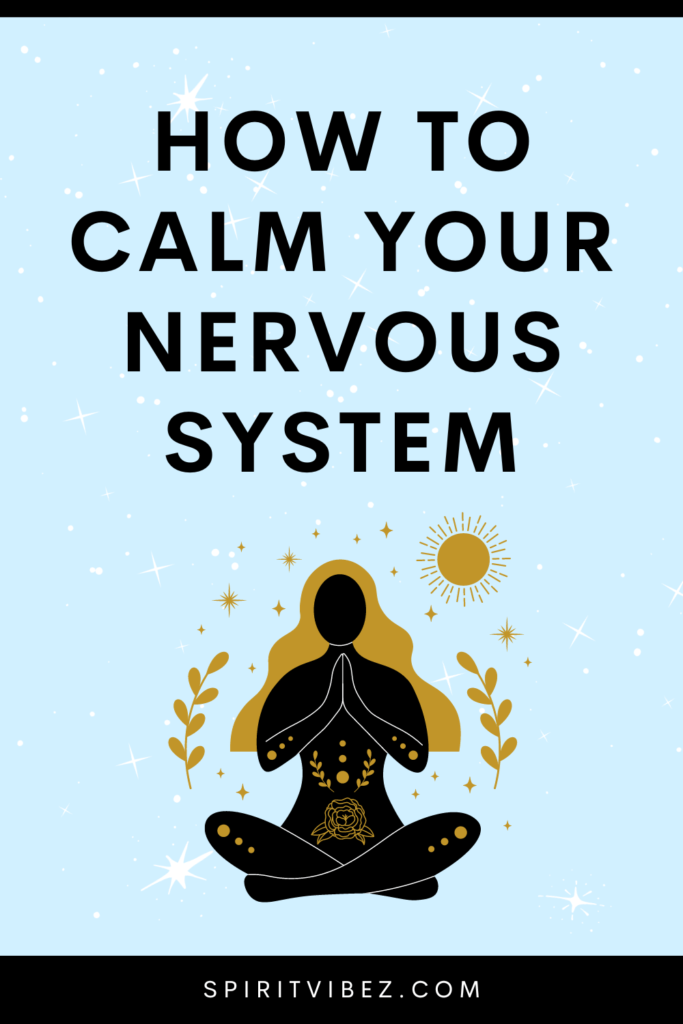Last Updated on January 11, 2024

Ever find yourself caught in the whirlwind of life, feeling as if your nerves are on high alert, and your stress levels are soaring?
The modern world, with its fast-paced demands and constant stimuli, can take a toll on our nervous systems. But fear not – the path to tranquility begins with a simple question: How can we calm the storm within and bring a sense of peace to our restless nerves?
In this article, you’ll learn how to calm your nervous system quickly, signs of a dysregulated nervous system, and signs that it’s healing.
Signs of a dysregulated nervous system
A dysregulated nervous system can manifest in various ways, impacting both physical and mental well-being. Here are some signs and symptoms associated with a dysregulated nervous system:
1. Difficulty concentrating: A dysregulated nervous system can affect cognitive function, leading to difficulties in focusing, concentrating, and maintaining attention on tasks.
2. Sleep disturbances: Both hyperarousal and hyperarousal can contribute to sleep issues. If you have an overactive nervous system, you may experience difficulties falling asleep, while those with an underactive system may struggle with excessive sleepiness.
3. Emotional dysregulation: Fluctuations in mood, heightened emotional responses, irritability, or difficulty managing stress can be indicative of a dysregulated nervous system.
4. Muscle tension and pain: Chronic muscle tension, aches, or pain may result from a nervous system that is stuck in a state of heightened alertness or stress.
5. Digestive issues: Dysregulation of the autonomic nervous system can impact digestion, leading to symptoms such as irritable bowel syndrome (IBS), indigestion, or changes in appetite.
6. Sensory sensitivities: Heightened sensitivity to sensory stimuli, such as light, sound, or touch, may be present when you have a dysregulated nervous system.
7. Increased heart rate and breathing: An overactive sympathetic nervous system can lead to an increased heart rate, rapid breathing, and a sense of being on edge.
8. Chronic stress: Prolonged exposure to stress without adequate relaxation or recovery can contribute to nervous system dysregulation.
9. Difficulty relaxing: The inability to unwind, relax, or experience a sense of calmness, even during non-stressful situations, may indicate a dysregulated nervous system.
10. Memory issues: Cognitive functions, including memory recall, may be affected by a nervous system that is not functioning optimally.
11. Hyperactivity or hypoactivity: An overactive nervous system may lead to symptoms of hyperactivity, restlessness, and difficulty relaxing. On the other hand, an underactive nervous system might result in sluggishness, fatigue, and a lack of energy.
It’s essential to note that these signs and symptoms can be influenced by various factors, and the presence of one or more does not necessarily confirm a dysregulated nervous system.
How to calm an overactive nervous system
Calming an overactive nervous system involves adopting strategies that promote relaxation, reduce stress, and create a sense of balance. Here are some techniques that may help calm an overactive nervous system:
1. Deep breathing exercises
To calm an overactive nervous system, deep breathing exercises offer a powerful tool.
Practicing diaphragmatic breathing becomes essential, focusing on the slow, controlled intake and release of breath. It’s about inhaling deeply through the nose, allowing the diaphragm to expand, and exhaling gradually through the mouth.
Specific techniques, like box breathing, can be incorporated to establish a rhythmic and intentional breathing pattern. This deliberate focus on breath serves to bring about both physiological and psychological benefits, promoting a profound sense of relaxation and balance.
2. Progressive muscle relaxation (PMR)
Engaging in progressive muscle relaxation (PMR) becomes a valuable practice. This involves a systematic approach of tensing and subsequently releasing different muscle groups throughout the body.
The key is to pay meticulous attention to each muscle group, discerning the subtle transition from tension to relaxation.
By combining PMR with intentional deep breathing, the physical tension is released, inducing a state of deep relaxation. It becomes a process of cultivating awareness of the body’s response to stress and actively working towards alleviating it.
3. Mindfulness meditation
Mindfulness meditation proves effective in staying present and cultivating awareness, crucial for reducing anxiety and stress associated with an overactive nervous system.
Experimenting with various mindfulness meditation styles, such as body scan or loving-kindness meditation, allows for a personalized approach.
Gradually extending the duration of meditation sessions deepens the impact, fostering a heightened sense of self-awareness and tranquility.
4. Yoga or tai chi
Participating in gentle, mindful movement practices like yoga or tai chi offers a holistic approach to calming the nervous system. These activities combine breathwork with physical movement, promoting relaxation and stress reduction.
Exploring different styles of yoga or tai chi helps in finding the practice that resonates best.
Emphasizing the integration of breath with movement enhances the mind-body connection, creating a fluid and calming experience.
5. Guided visualization
Guided visualization involves listening to or creating scenarios that you visualize to evoke a sense of peace and calm. It becomes a powerful tool for shifting focus away from stressors.
By imagining peaceful scenes or positive outcomes, the mind is redirected towards tranquility.
6. Aromatherapy
Aromatherapy, utilizing calming scents like lavender or chamomile through essential oils, introduces elements to the calming process. Inhaling these soothing aromas has a direct impact on the nervous system, inducing relaxation.
Experimenting with various essential oils and methods, such as diffusers or topical applications, allows for a personalized approach to harnessing the calming potential of aromatherapy.
7. Limit stimulants
Reducing or eliminating stimulants like caffeine and nicotine becomes crucial, especially in the hours leading up to bedtime. These substances can contribute significantly to an overactive nervous system, disrupting the natural winding-down process.
Gradually minimizing stimulant intake, and replacing these habits with healthier alternatives, ensures a smoother transition towards relaxation and better sleep quality.
8. Create a relaxing routine
Establishing a calming bedtime routine becomes a signal to the body that it’s time to wind down. This routine might include activities like reading, taking a warm bath, or practicing relaxation exercises.
Customizing the routine with elements that personally induce relaxation adds a sense of familiarity and comfort, preparing both the mind and body for a restful night.
9. Disconnect from screens
Limiting exposure to electronic screens, especially before bedtime, acknowledges the disruptive impact of blue light on melatonin production.
Establishing a winding-down period that involves low-light activities, such as reading a physical book or practicing relaxation techniques, helps signal to the body that it’s time to prepare for sleep.
Implementing blue light filters on electronic devices during the evening hours becomes a mindful step towards a more calming pre-sleep environment.
10. Limit stressors
Identifying and limiting exposure to stressors in the environment requires a proactive approach. This may involve setting boundaries, prioritizing tasks, or seeking support in managing challenging situations.
Developing effective stress management strategies, such as problem-solving skills or cognitive-behavioral techniques, empowers you to navigate stressors more efficiently.
Regularly reassessing and adjusting stressors and coping mechanisms based on changing circumstances becomes integral to maintaining a balanced and calm nervous system.
11. Hydrate and maintain nutrition
Ensuring adequate hydration and maintaining a healthy diet are fundamental aspects of supporting the nervous system. Dehydration and nutritional imbalances can contribute to stress and impact the functioning of the nervous system.
Consider incorporating foods rich in magnesium, omega-3 fatty acids, antioxidants, and vitamins like B-complex, which are known to support cognitive function and alleviate stress.
12. Quality sleep
Prioritizing quality sleep involves creating a comfortable sleep environment and adhering to a consistent sleep schedule.
Investing in a comfortable mattress, controlling room temperature, and minimizing noise and light disruptions contribute to an environment conducive to restful sleep.
Integrating relaxation techniques before bedtime, such as deep breathing or gentle stretching, establishes a calming pre-sleep routine, setting the stage for a night of rejuvenating sleep.
Signs your nervous system is healing
The nervous system is complex, and its healing process can vary from person to person. However, some general signs may indicate positive changes and healing within the nervous system:
1. Improved sleep quality: Better sleep patterns, including falling asleep more easily, staying asleep, and waking up feeling more rested, can be a sign of nervous system healing.
2. Reduced anxiety levels: Decreased feelings of anxiety and a greater ability to manage stress are positive indicators of nervous system healing.
3. Enhanced mood stability: More stable and balanced moods, with fewer mood swings or extreme emotional fluctuations, may suggest improvements in nervous system function.
4. Increased energy levels: Gradual increases in energy levels and reduced feelings of fatigue can be signs that the nervous system is functioning more optimally.
5. Improved cognitive function: Better cognitive abilities, including enhanced focus, concentration, and memory, may indicate healing within the nervous system.
6. Balanced stress response: An improved ability to handle stress and a more balanced stress response, characterized by quicker recovery after stressors, may suggest nervous system healing.
7. Reduced physical symptoms: A decrease in physical symptoms associated with nervous system dysregulation, such as headaches, muscle tension, or digestive issues, can be positive signs of healing.
8. Enhanced immune function: A stronger immune system and improved ability to fight off infections may be linked to a healthier nervous system.
9. Better regulation of autonomic functions: Improved regulation of autonomic functions, such as heart rate, breathing, and blood pressure, can be indicative of nervous system healing.
10. Increased resilience: Greater emotional and mental resilience, along with an increased ability to bounce back from challenges, may suggest improvements in nervous system health.
11. Improved sensory processing: If you have experienced sensory sensitivities or disruptions, noticing a reduction or better management of these sensitivities can be a sign of nervous system healing.
12. Enhanced mind-body connection: Feeling more connected and attuned to your body, with a heightened awareness of sensations and emotions, may indicate positive changes in the nervous system.
It’s important to note that the healing process can be gradual, and improvements may occur over an extended period. Additionally, individual responses can vary, and these signs are not definitive indicators for everyone.
If you are concerned about your nervous system, it’s advisable to consult with healthcare professionals or specialists who can provide a thorough assessment and guidance based on your specific situation.
If you enjoyed this article on how to calm your nervous system, I would be grateful if you shared it on Twitter, Facebook, or Pinterest! Thank you❤️
📌 PIN THIS POST FOR LATER


Hello, my name is Sara and I am the founder of Spiritvibez, I’m here to guide you on your spiritual journey toward healing, growth, and self-discovery. I believe that true transformation occurs when the mind, body, and spirit are aligned and working in harmony. Through Spiritvibez, I hope to inspire and empower you to deepen your spiritual practice, embrace your authentic self, and begin living your best life.
